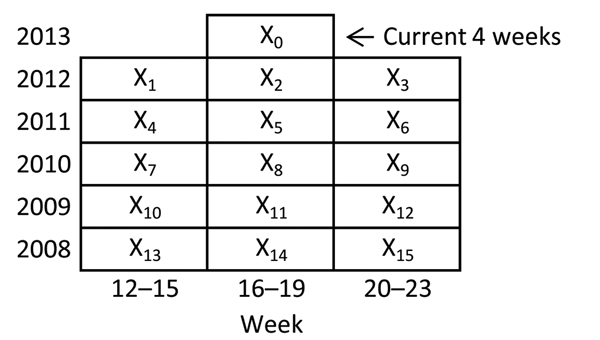Volume 21, Number 2—February 2015
Research
Refining Historical Limits Method to Improve Disease Cluster Detection, New York City, New York, USA
Figure 1

Figure 1. Following Stroup et al. (21), a schematic of the periods included in analyses using the historical limits method.
References
- Hutwagner L, Thompson W, Seeman GM, Treadwell T. The bioterrorism preparedness and response Early Aberration Reporting System (EARS). J Urban Health. 2003;80(Suppl 1):i89–96 .PubMedGoogle Scholar
- Farrington P, Andrews N. Outbreak detection: application to infectious disease surveillance. In: Brookmeyer R, Stroup DF, editors. Monitoring the health of populations. New York: Oxford University Press; 2004. p. 203–31.
- Choi BY, Kim H, Go UY, Jeong J-H, Lee JW. Comparison of various statistical methods for detecting disease outbreaks. Comput Stat. 2010;25:603–17. DOIGoogle Scholar
- Schuman SH. When the community is the “patient”: clusters of illness. environmental epidemiology for the busy clinician. London: Taylor & Francis; 1997.
- Unkel S, Farrington CP, Garthwaite PH. Statistical methods for the prospective detection of infectious disease outbreaks: a review. J R Stat Soc Ser A Stat Soc. 2012;175:49–82. DOIGoogle Scholar
- Stroup DF, Williamson GD, Herndon JL, Karon JM. Detection of aberrations in the occurrence of notifiable diseases surveillance data. Stat Med. 1989;8:323–9. DOIPubMedGoogle Scholar
- Farrington CP, Andrews NJ, Beale D, Catchpole MA. A statistical algorithm for the early detection of outbreaks of infectious disease. J R Stat Soc Ser A Stat Soc. 1996;159:547–63. DOIGoogle Scholar
- Hutwagner LC, Maloney EK, Bean NH, Slutsker L, Martin SM. Using laboratory-based surveillance data for prevention: an algorithm for detecting Salmonella outbreaks. Emerg Infect Dis. 1997;3:395–400 . DOIPubMedGoogle Scholar
- Strat YL. Overview of temporal surveillance. In: Lawson AB, Kleinman K, editors. Spatial and syndromic surveillance for public health. Chichester (UK): John Wiley & Sons; 2005. p. 13–29.
- Serfling RE. Methods for current statistical analysis of excess pneumonia-influenza deaths. Public Health Rep. 1963;78:494–506. DOIPubMedGoogle Scholar
- Noufaily A, Enki DG, Farrington P, Garthwaite P, Andrews N, Charlett A. An improved algorithm for outbreak detection in multiple surveillance systems. Stat Med. 2013;32:1206–22. DOIPubMedGoogle Scholar
- Wharton M, Price W, Hoesly F, Woolard D, White K, Greene C, Evaluation of a method for detecting outbreaks of diseases in six states. Am J Prev Med. 1993;9:45–9 .PubMedGoogle Scholar
- Centers for Disease Control and Prevention. Proposed changes in format for presentation of notifiable disease report data. MMWR Morb Mortal Wkly Rep. 1989;38:805–9 .PubMedGoogle Scholar
- Centers for Disease Control and Prevention. Notes from the field: Yersinia enterocolitica infections associated with pasteurized milk—southwestern Pennsylvania, March–August, 2011. MMWR Morb Mortal Wkly Rep. 2011;60:1428 .PubMedGoogle Scholar
- Rigau-Pérez JG, Millard PS, Walker DR, Deseda CC, Casta-Velez A. A deviation bar chart for detecting dengue outbreaks in Puerto Rico. Am J Public Health. 1999;89:374–8. DOIPubMedGoogle Scholar
- Pervaiz F, Pervaiz M, Abdur Rehman N, Saif U. FluBreaks: early epidemic detection from Google flu trends. J Med Internet Res. 2012;14:e125. DOIPubMedGoogle Scholar
- Winscott M, Betancourt A, Ereth R. The use of historical limits method of outbreak surveillance to retrospectively detect a syphilis outbreak among American Indians in Arizona. Sex Transm Infect. 2011;87:A165. DOIGoogle Scholar
- Hutwagner L, Browne T, Seeman GM, Fleischauer AT. Comparing aberration detection methods with simulated data. Emerg Infect Dis. 2005;11:314–6. DOIPubMedGoogle Scholar
- New York City Department of Health and Mental Hygiene. Communicable disease surveillance data [cited 2013 Nov 15]. http://www.nyc.gov/html/doh/html/data/cd-epiquery.shtml
- Nguyen TQ, Thorpe L, Makki HA, Mostashari F. Benefits and barriers to electronic laboratory results reporting for notifiable diseases: the New York City Department of Health and Mental Hygiene experience. Am J Public Health. 2007;97(Suppl 1):S142–5. DOIPubMedGoogle Scholar
- Stroup DF, Wharton M, Kafadar K, Dean AG. Evaluation of a method for detecting aberrations in public health surveillance data. Am J Epidemiol. 1993;137:373–80 .PubMedGoogle Scholar
- United Hospital Fund. Neighborhoods. New York City community health atlas: sources, methods and definitions. New York: United Hospital Fund; 2002. p. 2–3.
- Centers for Disease Control and Prevention. Comparison of provisional with final notifiable disease case counts—National Notifiable Diseases Surveillance System, 2009. MMWR Morb Mortal Wkly Rep. 2013;62:747–51 .PubMedGoogle Scholar
- Lotze T, Shmueli G, Yahav I. Simulating multivariate syndromic time series and outbreak signatures [cited 2014 Dec 3]. http://papers.ssrn.com/sol3/papers.cfm?abstract_id=990020
- Centers for Disease Control and Prevention. Simulation data sets for comparison of aberration detection methods. 2004 April 16, 2004 [cited 2013 Aug 30]. http://www.bt.cdc.gov/surveillance/ears/datasets.asp
- Layton M. Increase in reported legionellosis cases. 2013 [cited 2013 Sep 18]. https://a816-health29ssl.nyc.gov/sites/NYCHAN/Lists/AlertUpdateAdvisoryDocuments/2013-07-03%20HAN_Legionella%20final2.pdf
- Kulldorff M, Heffernan R, Hartman J, Assuncao R, Mostashari F. A space–time permutation scan statistic for disease outbreak detection. PLoS Med. 2005;2:e59. DOIPubMedGoogle Scholar
1Current affiliation: RTI International, Research Triangle Park, North Carolina, USA.
2Current affiliation: Colorado Department of Public Health and Environment, Denver, Colorado, USA.
Page created: January 20, 2015
Page updated: January 20, 2015
Page reviewed: January 20, 2015
The conclusions, findings, and opinions expressed by authors contributing to this journal do not necessarily reflect the official position of the U.S. Department of Health and Human Services, the Public Health Service, the Centers for Disease Control and Prevention, or the authors' affiliated institutions. Use of trade names is for identification only and does not imply endorsement by any of the groups named above.